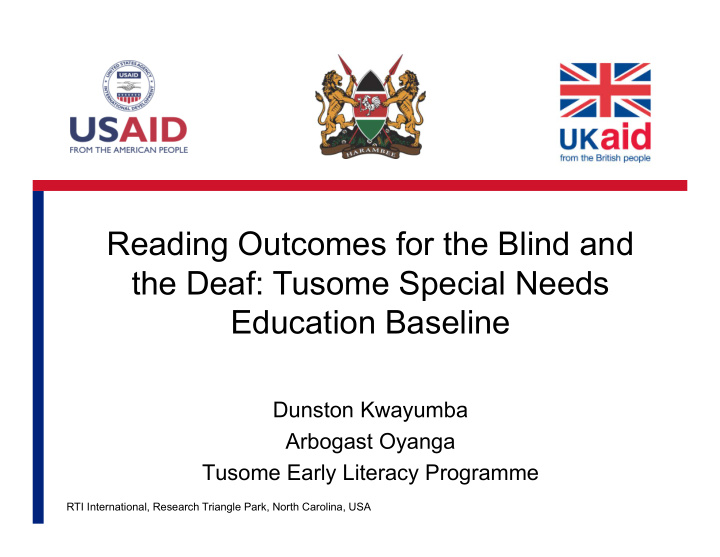



Reading Outcomes for the Blind and the Deaf: Tusome Special Needs Education Baseline Dunston Kwayumba Arbogast Oyanga Tusome Early Literacy Programme RTI International, Research Triangle Park, North Carolina, USA
Tusome Early Literacy Programme 1. Objective: MoE Program aimed at improving literacy Outcomes for children at early grades. 2. Scope: Regular primary schools, APBETs, SNE 3. Methods: Teaching and learning materials, training and supervision 4. Duration: 2015 - 2019
SNE Baseline Study Objectives • Establish a baseline to measure impact of the intervention – Establish literacy outcomes for the blind and the deaf – Variation of outcomes by gender and grade – Establish factors related to literacy outcomes for the blind and the deaf
Research Design and Methodology • Cross-sectional design • Respondents – Deaf children at class 1 and 2 – Blind children at class 1 and 2 – Teachers in schools for the blind and the deaf and head teachers of sampled schools • Instruments – Early Grade Reading Assessment (EGRA) adapted for the deaf and the blind • Blind pupils assessed using both English EGRA and Kiswahili • Deaf pupils assessed using English EGRA – Teacher and head teacher assessor administered questionnaires
Research Design and Methodology…ctnd • Sample – Undertook a census for schools for the blind – Schools for the deaf selected using the method of proportionate to population – 4 pupils at each grade targeted; systematic sampling was used for cases with more than 4 pupils per class. – Gender representation was established where possible – Head teachers and teachers interviewed for the selected sample
Research Design and Methodology…ctnd • Adaptation of instruments – Undertaken in collaboration with staff from KISE and MoE directorate of SNE – Two panels: one for instruments for the deaf and the other one for the blind – Instruments piloted in schools for the deaf and the blind • Enumerator recruitment and training – Specialized assessors: Braille readers and those who could sign – Trained for one week, assessed and IRR established – Undertook instrument field testing on one of the days
Major Findings – Response Rates Blind pupil sample Deaf pupil sample Gender Class 1 Class 2 Total Gender Class 1 Class 2 Total Boys 37 35 72 Boys 77 80 157 Girls 31 28 59 Girls 72 69 141 Total 68 63 131 Total 149 149 298
Performance of Blind Pupils in English Subtasks by Grade Class 1 Outcomes Class 2 Outcomes Subtask Boys Girls Total Subtask Boys Girls Total Letter sound 11.9 8.3 10.3 Letter sound 18.4 24.0 21.6 fluency fluency Segmentation 47.4 51.9 49.9 Segmentation 66.1 70.9 68.7 score (%) score (%) Familiar word 7.5 4.2 5.7 Familiar word 10.2 13.6 12.1 fluency fluency Oral reading 7.4 5.0 6.1 Oral reading 15.7 19.9 18.1 fluency fluency Reading 15.4 13.0 14.1 Reading 36.4 44.0 40.6 comprehension comprehension ORF (regular) 15.9 ORF (regular) 36.8
Performance of Blind Pupils in Kiswahili Subtasks by Grade Class 1 Outcomes Class 2 Outcomes Subtask Boys Girls Total Subtask Boys Girls Total Letter sound 11.1 8.9 9.9 Letter sound 18.4 26.2 22.7 fluency fluency Syllable fluency 7.6 6.5 7.0 Syllable fluency 14.9 20.3 17.9 Familiar word 4.3 3.7 4.0 Familiar word 10.1 12.4 11.4 fluency fluency Oral reading 4.0 3.2 3.6 Oral reading 9.0 11.5 10.4 fluency fluency Reading 16.7 13.0 14.7 Reading 37.1 44.6 41.3 comprehension comprehension ORF(Regular) 10.1 ORF(Regular) 22.9
Performance of Deaf Pupils in EGRA English Subtasks by Grade Class 1 Outcomes Class 2 Outcomes Subtask Boys Girls Total Subtask Boys Girls Total Letter sign 31.6 30.0 30.7 Letter sign 43.4 36.8 39.8 fluency fluency Familiar word 1.8 1.8 1.8 Familiar word 5.4 4.5 4.9 signage signage Sign reading 5.4 4.8 5.1 Sign reading 13.1 8.6 10.7 fluency fluency Signing 1.1 3.9 2.6 Signing 3.2 4.8 4.0 comprehension comprehension score(%) score(%) ORF (regular) 15.9 ORF(regular) 36.8
Signing Fluency Predictors Pupil has other books at home 4.8 Signs in SEE at school 4.8 Mother can read and write 4.3 RTI staff undertakes at least 3… 4.1 Signs in SEE at home 4.1 Signs in KSL at home 4.0 Signs in KSL at school 3.9 Father can sign 3.5 Father can read and write 3.4 Pupil has sign language textbook at… 3.4 Pupil has English textbook at home 3.3 Was attending this school in January… 3.1 Mother can sign 2.9 Teacher uses SEE in instrution 2.6 Attended pre-school 2.5 -5.9 Language used at school not known -6.4 Language used at home not known 8 0 6 0 4 0 2 0 0 0 2 0 4 0 6 0
Braille Reading Fluency Predictors English book in Braille 14.2 Mother can read and write 7.9 Speaks English at school 6.4 Repeated class -8.3 Speaks mother-tongue at school -8.9 Other books/reading materials in -8.9 mother-tongue at home -15.0 -10.0 -5.0 0.0 5.0 10.0 15.0 20.0
Challenges • Signing language mix-up between KSL and SEE • Assessors proficient in higher grade level Braille while learners use grade 1 • Data on SNE is not accurate as a sampling frame • Costs – higher than studies for regular children
Recommendations • Implement interventions to improve literacy • Advocate for a standardized sign language • Provide better instructional support • Encourage the use of appropriate languages at school and home • Harness parental involvement and support
Recommendations….cntd • Promote school attendance and pre-school • Develop reading benchmarks for the deaf and the blind • Develop / re-evaluate the language policy for the deaf Conclusion Blind and deaf pupils need concerted intervention to improve literacy outcomes. The Tusome endline evaluation will establish the effectiveness of Tusome interventions.
Q & A Thank you 16
Recommend
More recommend